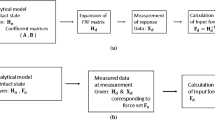Abstract
Frequency response functions (FRFs) can be estimated only from responses of structures without knowledge of input forces. Mode shapes identified from operational modal analysis (OMA) methods are unscaled, and the unscaled mode shapes provide unscaled FRFs. In this paper, mass change and mass–stiffness methods are employed to construct FRFs from the response-only measurements. A numerical case study of a cantilever beam is investigated using the finite element method. It is shown that the mass–stiffness change method provides more accurate results compared to the mass change method in the low-frequency range. A laboratory-scale steel beam is also tested using an OMA method and conventional hammer test. The experimental results show better accuracy of the identified FRFs in the low-frequency range when the mass–stiffness method is used.















Similar content being viewed by others
References
Ewins, D.J.: Modal Testing; Theory, Practice and Application. Research Studies Press Ltd, London (2000)
Hanson, D.: Operational Modal Analysis and Model Updating with a Cyclostationary Input. University of New South Wales, Sydney (2006)
Brincker, R., Ventura, C., Andersen, P.: Why output-only modal testing is a desirable tool for a wide range of practical applications. In: Proceedings of the International Modal Analysis Conference (IMAC) XXI, Paper (2003)
Parloo, E., Verboven, P., Guillaume, P., Van Overmeire, M.: Sensitivity-based operational mode shape normalisation. Mech. Syst. Signal Process. 16(5), 757–767 (2002)
Coppotelli, G.: On the estimate of the FRFs from operational data. Mech. Syst. Signal Process. 23(2), 288–299 (2009)
Khatibi, M., Ashory, M., Malekjafarian, A.: Scaling of mode shapes using mass-stiffness change method. In: Proceedings of the International Operational Modal Analysis Conference (IOMAC). Copenhagen, Denmark, pp. 699–706 (2009)
Devriendt, C., De Troyer, T., De Sitter, G., Guillaume, P.: Transmissibility-based operational modal analysis for flight flutter testing using exogenous inputs. Shock Vib 19(5), 1071–1083 (2012). https://doi.org/10.3233/Sav-2012-0713
Agneni, A., Coppotelli, G., Grappasonni, C.: Output-only analyses in environmental testing. In: International Operational Modal Analysis Conference, Istanbul, Turkey (2011)
Mao, X., Luo, B., Li, B., Cai, H., Liu, H., Pen, F.: An approach for measuring the FRF of machine tool structure without knowing any input force. Int. J. Mach. Tools Manuf. 86, 62–67 (2014)
Cai, H., Mao, X., Li, B., Luo, B.: Estimation of FRFs of machine tools in output-only modal analysis. Int. J. Adv. Manuf. Technol. 77(1–4), 117–130 (2015)
Khatibi, M., Ashory, M., Malekjafarian, A., Brincker, R.: Mass-stiffness change method for scaling of operational mode shapes. Mech. Syst. Signal Process. 26, 34–59 (2012)
Lopez-Aenlle, M., Fernandez, P., Brincker, R., Fernandez-Canteli, A.: Scaling-factor estimation using an optimized mass-change strategy. Mech. Syst. Signal Process. 24(8), 3061–3074 (2010)
van Overschee, P., de Moor, B.L.: Subspace Identification for Linear Systems: Theory — Implementation — Applications. Springer (1996)
Brincker, R., Zhang, L., Andersen, P.: Modal identification from ambient responses using frequency domain decomposition,# 293. In: Proceedings of IMAC-XVIII: A Conference on Structural Dynamics, p. 625 (2000)
Brincker, R., Ventura, C., Andersen, P.: Damping estimation by frequency domain decomposition. IMAC XIX, Kissimmee 9, 72 (2001)
Brincker, R., Andersen, P.: Understanding stochastic subspace identification. In: Proceedings of the 24th IMAC, St. Louis, Missouri, pp. 279–311 (2006)
Peeters, B.: System Identification and Damage Detection in Civil Engineering. Department of Civil Engineering, Katholieke Universiteit Leuven, Leuven, p. 233 (2000)
Khatibi, M., Ashory, M., Albooyeh, A.: Determination of scaled mode shapes in response only modal analysis. In: Proceedings of 27th International Modal Analysis Conference (IMAC XXVII) (2009)
Liu, G., Quek, S.: The Finite Element Method: A Practical Course. Department of Mechanical Engineering National University of Singapore Butterworth, Heinemann (2003)
MODPLAN.: Integrated Software for Structural Dynamics. ICATS Imperial College of Science, Technology and Medicine, University of London (1988–2000)
Imamovic, N.: Validation of Large Structural Dynamics Models Using Modal Test Data. Imperial College of Science, Technology and Medicine, London (1998)
PULSE.: 8.0 edn. Brüel & Kjær, Sound and Vibration Measurement A/S (1996–2003)
Author information
Authors and Affiliations
Corresponding author
Appendix
Appendix
The transformations from Eqs. (5), (6) are presented here.
By subtracting Eq. (5) from Eq. (4), the following relation is obtained:
Considering small mass and stiffness changes, the mode shapes before and after modification change negligibly, i.e.
Considering Eqs. (16), (15) can be simplified as:
Pre-multiplying by \(\left\{ \phi \right\} ^{t}\) and considering orthogonality of mode shapes, Eq. (17) becomes:
By substituting Eq. (2) into Eq. (18), the following equation is obtained:
Rights and permissions
About this article
Cite this article
Behnam, M.R., Khatibi, M.M. & Malekjafarian, A. An accurate estimation of frequency response functions in output-only measurements. Arch Appl Mech 88, 837–853 (2018). https://doi.org/10.1007/s00419-018-1345-2
Received:
Accepted:
Published:
Issue Date:
DOI: https://doi.org/10.1007/s00419-018-1345-2




